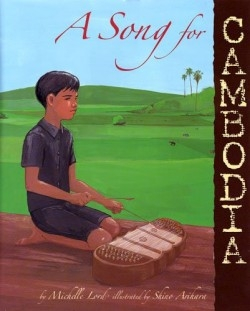Song for Cambodia
In 1975, Pol Pot gained control of Cambodia, “a country of sugar palms, whispering grasses, and bright sunshine.” Arn Chorn-Pond, whose biography this is, was eight years old. He lived in a prosperous village in northern Cambodia surrounded by natural beauty. At first, it seemed that the violence creeping up from the south might not reach Arn’s village, but by summer, “a group of soldiers called the Khmer Rouge, or ‘Red Khmers,’ spread through the land like army ants….Hospitals were emptied and temples crushed. Schools were made into prisons and books burned in fires. Songbirds stopped chirping, and monks were silenced. Art, music, and religion disappeared from people’s lives.”
One day, soldiers arrive in Arn’s village, and Arn is literally torn from his mother’s arms. He is sent to a children’s work camp, where he slaves in the rice paddies “from sunrise to midnight.” His feet are bare, and his stomach takes on the familiar distension of malnutrition. Desperate, the children catch “dragonflies, beetles, or grubs to eat.”
When the soldiers ask for volunteers for a musical group, Arn is chosen to learn the khim, an instrument that resembles a dulcimer. Instead of working in the rice paddies, his job is now to play for the child workers and their guards.
When South Vietnam invades Cambodia, Arn has been in the labor camp for four years. Arn learns that he was to be sent to fight the South Vietnamese; instead he runs away, into the jungle, where he survives for three months before collapsing with a “raging fever,” only a few miles from the Thai border. At a refugee camp in Thailand, he meets Reverend Peter Pond, who adopts him and brings him to America.
After a difficult adjustment to American life, Arn Chorn-Pond devoted himself to using his musical talents to work with at-risk youth. He has won several humanitarian awards and has dedicated himself to recovering lost Cambodian music, since much of it was transmitted orally.
This is author Michelle Lord’s second book. Her storytelling is matter-of-fact, yet also deeply emotional. Shino Arihara’s gouache illustrations reinforce the emotions evoked by Arn’s tale. Her carefully chosen palette takes readers on Arn’s journey from light to darkness, and then back to light, as each full-color page brings readers into the story a little more viscerally than they might otherwise.
Reviewed by
Elizabeth Breau
Disclosure: This article is not an endorsement, but a review. The publisher of this book provided free copies of the book to have their book reviewed by a professional reviewer. No fee was paid by the publisher for this review. Foreword Reviews only recommends books that we love. Foreword Magazine, Inc. is disclosing this in accordance with the Federal Trade Commission’s 16 CFR, Part 255.

